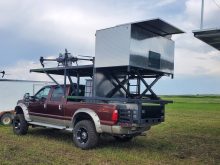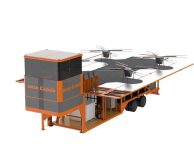Glacier FarmMedia — Precision agriculture has simplified many on-farm practices and procedures, particularly in the past five years as seen in the rush to automate tractors, planters and weed management systems.
But those are two-dimensional applications, and although those can go awry and complicate a grower’s plans, adding a third dimension — in the air — can result in something catastrophic.
That was Dr. Jason Deveau’s overriding message during his Southwest Agricultural Conference presentation in January at the University of Guelph’s Ridgetown Campus. The application technology specialist with the Ontario Ministry of Agriculture, Food and Rural Affairs (OMAFRA) pulled no punches on the potential use of drones in spray applications.
Read Also

Cancer agency reclassifies another herbicide ‘probably carcinogenic’
The WHO’s cancer research agency has now put atrazine, a herbicide well known to corn growers, in the same potential-hazard category where the agency put glyphosate.
For starters, spraying pesticides via an unmanned aerial vehicle (UAV) or drone is illegal — and for very valid reasons, Deveau explains.
The flight and speed dynamics at which planes and helicopters fly cause the spray to “lay out” in a level or horizontal flow, whereas drones are constantly forcing air downward.
Walking attendees through several videos, Deveau briefly explained how sprays behave behind a helicopter or a plane, noting no crop disturbance below.
“The only thing that affects spray deposition behind a plane or a helicopter is gravity, the wind that blows it around and any forward momentum from the vehicle itself,” he says. “Drones, however, always have a downward component no matter how fast they fly. They are always in hover or transitional flight, which means they’re always blowing down.”
The number of rotors, droplet size and distribution — and where the droplet is released relative to the rotor — complicates the application. Fine droplet spray is susceptible to the wind effect of the rotor. If released close to the centre of the drone, droplets react like a tornado, and droplets released at the wing tip will be thrown all over the place, Deveau says.
Part of that dynamic comes from drone design, with rotors spinning at variable rates and relative speeds not fixed to one another.
“The reason a drone can stay so eerily still is because all of those rotors spin at different speeds depending on what the wind is doing,” Deveau says.
“Which means the effect of that wind, that down-wash on a droplet, changes from moment to moment, and it’s not just one of them, it could be four or two or eight (rotors).”
Next on his list of concerns was the plumbing of a drone. Drone size limits its chemical volume carrying capability to a fraction of a ground applicator, resulting in lower volumes at very concentrated rates.
Ask any agrochemical expert, he says, and they’ll say chemical formulations are precise and complicated with the intent of dilution to a specific degree.
“That changes how the product moves and how it dissolves and ultimately, it changes how it reacts when it hits a plant surface,” Deveau adds. “If you hyper-concentrate but put in low volume, what’s going to happen? We don’t know. Sometimes it’s good; sometimes you need a toothbrush.”
If understanding droplet size and the effect of the number of rotors on spray distribution, volumes and concentrations isn’t complex enough, the drone weight — empty or full — also affects spray patterns.
Deveau provided video examples of fields with drone-applied sprays — using dyed water only — and the results were evident when compared to ground or even hand applications (typical in greenhouses).
In one slide, the drone’s spray pattern drifted beyond an established buffer zone; perhaps the altitude was a little high, it wasn’t at optimal flight speed, or spraying at the correct pressure.
Where is it leading?
According to Deveau, the road ahead for drone technology use in chemical spray applications is long and arduous and requires more research to determine how to lower existing risks when using the devices.
Many of the efficiencies and nuances of drone technology are unknown and hard to establish. Thus far, research determined drone spray coverage is roughly five per cent versus conventional systems which are up to 10 per cent.
There are also concerns about operator exposure, drift potential, and the 10 per cent of product remaining in the air. It’s not just Agriculture and Agri-Food Canada (AAFC) involved but Transport Canada, as well, because many operators want to fly heavy drones in populated places, which requires an advanced pilot license, Deveau explains.
“If you’re talking about spreading fertilizer or cover crops, drones are really fantastic,” he says. “If you’re going to sneak out and spray pesticide — and I won’t lie, people are doing it — don’t do it. It’s illegal, and it’s not going to work for you. At least not consistently, and when it goes wrong, it goes wrong.”















